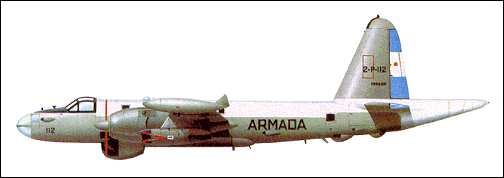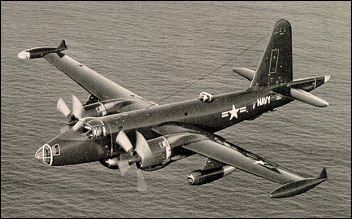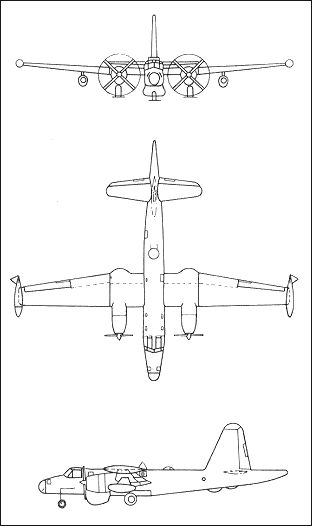|
| The first US Navy contract for two XP2V-1 Neptune maritime-reconnaissance bombers was placed in April 1944. The first prototype flew in 1945. From then Lockheed received contracts for the P2V-1 to P2V-7 versions which were subsequently redesignated in the P-2 category.
Last versions in operational service were the P-2E (formerly P2V-5) which introduced the glazed nose, MAD tailboom, Julie/Jezebel ASW systems, etc, and later fitted with auxiliary underwing turbojets; SP-2E, as for the P-2E but with modernised equipment; P-2H, the first version to introduce auxiliary underwing turbojets and incorporating equipment and detail changes; and the SP-2H, as for the P-2H but with modernised equipment. These served with the Argentinian Navy (P-2H), Australian Air Force (SP-2H), Brazilian Air Force (P-2E), French Navy (P-2H), JMSDF (P-2H, and Kawasaki P-2J), Netherlands Navy (SP-2H), Portuguese Air Force (SP-2E) and the US Navy (SP-2H).

| CREW | 7 |
| ENGINE | 2 x Wright R-3350-32W, 2575kW |
| WEIGHTS |
| Take-off weight | 36191 kg | 79788 lb |
| Empty weight | 22592 kg | 49807 lb |
| DIMENSIONS |
| Wingspan | 31.7 m | 104 ft 0 in |
| Length | 27.9 m | 92 ft 6 in |
| Height | 8.9 m | 29 ft 2 in |
| Wing area | 92.9 m2 | 999.97 sq ft |
| PERFORMANCE |
| Max. speed | 648 km/h | 403 mph |
| Ceiling | 6800 m | 22300 ft |
| Range w/max.fuel | 5930 km | 3685 miles |
| ARMAMENT | 2 x 12.7mm machine-guns, bombs, missiles, torpedos |
| Bill D. Simms, e-mail, 13.03.2009 01:35 I was in the Naval Reserve, vp-671, 1964 thru 1970. My rate was AX2 and i was a Julie and radar operator on a P2 flight crew for 5 years of active reserve duty. My pilot was also our C.O. and also flew all the time in his private business, therefore he was always current and our crew could fly the P2 anywhere, in any weather. I loved it. reply | | Frank Taylor, e-mail, 23.12.2008 23:06 I was a radarman in CIC on the USS Bataan cvl. 29from 1952-1954. We had a P2V Neptune doing sub chasing (we had a grid over the radar and guided them along the grid). When they started home to NaHa I had to give them a vector to get home, nothing on altitude. I followed them till they merged with a mountain and supposibly landed at Naha. The next morning we hear they crashed into the mountain. I felt bad but had no way of telling them the altitude to fly. reply | | Charles Holman, e-mail, 13.12.2008 06:30 I served with VP18 at roosey roads PR.and VP21 Brunswick Me.I was a ground pounder (ADJ-2) most of the times I still managed to get 180hours.The P-2 was a great plane.I still have nightmares about changing that #10 cyl.on that 3350eng.I'll never forget those years,1965-1969. reply | | Jackson I Newberry, Jr, e-mail, 30.09.2008 21:27 I flew P-2s for VP-4 1963-1966 in Hawaii. I am now retired, but there is a P2V-5 as a static display at the campus Southwestern Technical School in Americus, GA. reply | |
| | Kevin, 29.09.2008 07:43 While the RAAF operated the P-2 until replaced by the P-3 Orion, I never actually saw one in RAAF service (except in photos). However I was lucky enough to see a Neptune at Perth domestic airport in the late 1990s /early 2000s.
It had been converted to firebombing configuration and I believe was being offered by an American couple for hire to the Western Australian government to help fight bushfires although the West Aust government never took them up on the offer.
A mistake on their part as they had to buy & convert some crop dusting aircraft for exactly that purpose some time later and much later they decommissioned the planes and hired helicopters for the same task. After seeing the Neptune moved to another part of the domestic airport (and also locating it on Google Earth) sometime around 2002-03, I never saw it again and I believe that it is now gone from Western Australia. I don't have any details of the model type or history and I'm kicking myself now because I never thought to take any photos. reply | | Darryl Crum, e-mail, 01.09.2008 23:50 My brother was one of 12 men who died in the crash of a P2V in November 1964 just on the edge of Cape Newenham in Alaska. We are building a site to honor these 12 men, who were given the name Cape Cod 12 and the url is www.capecod12.org. I am aware of the memorial at Whidbey Island but would like to find out if anyone has additional information about this crash or this crew. Thank you. reply | | Ben Thurston, e-mail, 18.08.2008 19:14 I was a combat aircrew instructor in the SP2E and SP2H at Navy Jacksonville, FL 1962-1965 VP-30. We were a replacement air group. I operated, taught and maintained all the electronic equipment in the aircraft. Primary job code was Radio /Radar operator and first tech. Established the operations control point at NAS Roosevelt Roads, PR during the Cuban crisis. reply | | John Vavrek, e-mail, 27.07.2008 18:44 I was introduced to the P2V-7 at NAS North Island and trained in the Jez and Radio positions with VP31. I was then sent to VP2 at NAS Whidbey Island in early 1965 and served until late 1967. Rotated with the squadron to Japan, Viet Nam, Okinawa, Phillipines and Alaska. It was Great airplane to crew and very forgiving of our junior pilots. It brought me home twice on one Recip and two Jets(Westinghouse dump valves). I enjoyed it and there are days I miss it. Also, I believe I trained in VP31 with Jim Hart whose comments appear above. reply | | Jack Richardson, e-mail, 16.06.2008 16:58 I logged about 1000 hrs in a P2V-7 as a Navigator /Tac coordinator with VP-26 in the early '60s. We were looking over the Russian fishing fleet in the north atlantic and of course submarines. Most of the time we flew below 1000'
This was a very special part of my life. reply | | John William Paterson, e-mail, 08.06.2008 01:43 No mention of the fact that the RAF had quite a few of these very nice birds for some years. reply | | JOHN HANSELMAN, e-mail, 30.05.2008 22:36 I put in 2000 hrs in this bird. Loved it. Sure saw a lot of America, Europe, and Africa in this bird. Not to mention the God foresaken north atlantic. VP - 10. reply | | Bob Burke, e-mail, 29.05.2008 18:49 I had 2500 hours in the P-2 and loved it all. VP-9,VP-28 and VP-31 det North Island were my squadrons. Taught the Army "Crazy Cat" pilots at North Island. reply | | Doyle F. Howe, e-mail, 23.05.2008 03:17 While stationed at NAS Alameda (California, 1951 to 1952) I was assigned to the flight test division of Overhaul & Repair. When a airplane came of the rebuild line it was assigned to one of us Aviation Machinest Mates to make flight worthy. Tasks consisted of topping off the fuel tanks, fixing fuel leaks, engine run up /check out, swing the compass, ect. Then if it was not a single seater you made the first flight. Several models of the P-2V's went through overhaul there plus PV-2's, F6F HellCats, F8F Bearcats, F9F Cougars, AD Skyraiders, etc. Finished out my Navy tour of duty at Kodiak Naval Station flying in the Grumman UF-1 Albatros. The GI Benefit, Public Law 550 enabled me to later attain a BSME plus a job with Lockheed at Sunnyvale. While there I earned a Masters of Science in Engineering Mechanics and eventually worked on Satellites, Missiles, L-1011, SR-71, U-2, and various other unmentionables. I suppose I would be classified as an Aerospace Structural Engineer. Thanks to a kick start in the Navy at NAS Alameda as a greasy assed mechanic. reply | | Jerry Reinhardt, e-mail, 22.05.2008 18:34 I flew with VP-4 from 1954-57. We converted from P2V-5 to P2v-5F with the J-34 jet engines about halfway through my tour. We were also the designated mining squadron for the West Coast, so most of our planes had twin 20mm cannons in a ball in the nose, twin 50s on the top turret, plus twin 20 mm cannons in the tail. We flew out of Whidbey Island, Iwakuni, Japan, and Naha Okinawa for 3 years, and patrolled all the way from Vladivostok to Vietnam. A great airplane. reply | |
| | Daniel I. Karlin, e-mail, 22.05.2008 18:22 50 yrs ago I served as a naval aviator from 1953-57 and was assigned to VP-16 at JAX. After two deployments to Pt Lyautey, Morocco & Keflavik, Iceland as an Ensign and later a Lt(jg), became a PPC (Patrol plane commander) and had approx 1200 hrs as both PPC or crew. Space here does not allow me to describe what a great plane the P2V-5F was..Very dependable and safe. Lockheed did a fine job.. reply | | H W Thornhill, e-mail, 17.05.2008 03:49 I served in VP-21, stationed at Brunswick NAS,ME. In 1953, we were transitioning from P4M-1 Mercators to P2V-6Ms. On deployment to Malta, one of the -6Ms threw a blade from the starbord engine and in went into the fuselage behind the Co-Pilot. The aircraft landed without incident at Gibraltar. Myself and two other AMs were sent to repair the fuselage for ferry out following engine repair /replacement. Lockheed built good aircraft. reply | | Ken Clift, e-mail, 14.05.2008 06:20 I served in VW-4 (Hurricane Hunters) stationed at Naval Air Station Jacksonville, FL from 1956-59. Before transitioning to RC-121s, the P2V5JF version was the workhorse of the squadron. So many wavetop storm penetrations were made in this fabulously durable aircraft. She was forgiving, powerful and mighty! I later flew the P2V7 version in antisubmarine warfare roles. reply | | Lyle J. Anderson, e-mail, 04.05.2008 20:45 I was a co-pilot for Lt.Braden R. Briggs USN on flight from Sfo to Barbers Pt. 1959. Transpacing to Japan. Lost stbd eng. over station ship November. Flew our P2v-7 at 50 ft. for 1060 miles to Hilo. Great bird. It kept our feet dry. reply | | Jim Hart, e-mail, 04.05.2008 08:15 Served in VP17, NAS Whidbey from 65-67. Flew some 950 hrs in the P2V7 (SP2H). My plane commander was then LCDR David Krogh, now retired CDR and living in California. Best days of my life. Did the VietNam thing, Japan, Okinawa, Philipines. Great airplane. I was Jez /radio on crew 12. reply |
| Truman, e-mail, 30.04.2008 20:42 I flew the RP-2E configured for a Radio Research mission for the U.S. Army. Developed under Project Crazy Cat, the Army acquired 6 P2-E aircraft from the Navy. Five were configured for the mission, and the sixth was left in Navy configuration and used as a training ship. Army Aviators were trained by VP-31 at Navy North Island. Aircraft maintenance personnel were trained at Navy Mayport. We flew the five mission aircraft from the US to Vietnam in June 1967. The unit stayed in Vietnam for about five years. One RP-2E is on display at the Army Aviation Museum in Fort Rucker, AL. reply |
|
Do you have any comments?
|
| 
COMPANY
PROFILE
All the World's Rotorcraft
|









I served in VP 17 at the same time you did I was an AE2 in crew 11 with LCDR Jerry Jones crew 8 with LCDR William Eason. They were both maintanence officers. I really enjoyed my time there.
reply